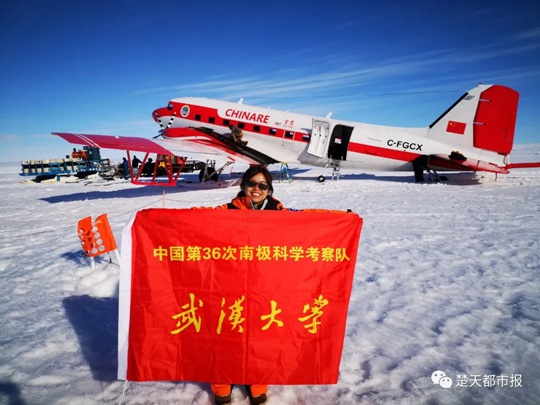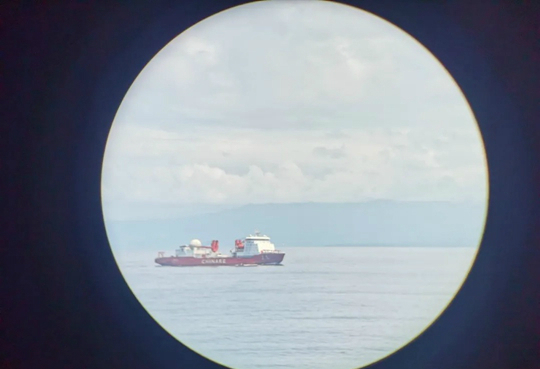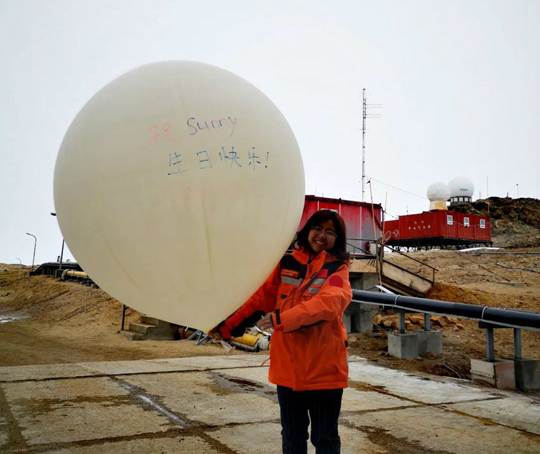A seventeen-day voyage on the Chinese icebreaking research vessel Xue Long and then another four-week nautical journey after transferring to the Xue Long 2.
These are not scenes from an adventure drama like the Life of Pi, but an actual inbound journey back home for Zhao Xi, a college professor in central China's Hubei Province, after finishing the country's 36th expedition to the Antarctic.

Zhao Xi, the associate professor in Wuhan University, as well as a member of the China's 36th Antarctic expedition team, conducts scientific research in the Antarctic. /Chutian Metro Daily
Zhao Xi, the associate professor in Wuhan University, as well as a member of the China's 36th Antarctic expedition team, conducts scientific research in the Antarctic. /Chutian Metro Daily
As an associate professor in Chinese Antarctic Center of Surveying and Mapping at Wuhan University, Zhao is also a member of China's 36th Antarctic expedition team. If not for the coronavirus outbreak worldwide, she and her teammates would have taken a flight to Australia before returning home by air.
Over the past few months, the pandemic has swept around the globe, hitting almost all but the world southernmost area. Though the place of barren ice had not seen a single case of the deadly disease confirmed then, China's Ministry of Natural Resources made a temporary decision that all of the country's Antarctic expedition team members were to return by way of the research vessels without berthing at any harbors in any countries, over concerns of the potential risks posed by the spread of the virus.
The day to set sail for the homeland finally came in mid-March. Zhao and her teammates started their journey onboard Xue Long, China's first polar research vessel. After spending seventeen days there, they then transferred to the country's first domestically-built research icebreaker Xue Long 2 for a voyage that lasted for 25 days.
While at an early stage of the journey, the two icebreakers sailed smoothly and reposefully over the Antarctic sea ice zone, the subsequent ocean currents of five-meter height still made many vomit with nausea when passing by the westerly wind belt.

The sight of the research vessel Xue Long watching from an upgraded Xue Long 2. /Chutian Metro Daily
The sight of the research vessel Xue Long watching from an upgraded Xue Long 2. /Chutian Metro Daily
On April 22, after sailing over 70,000 nautical miles during the 198-day expedition, all scientists, including Zhao Xi and her teammates eventually returned to Shanghai, marking the completion of China's 36th Antarctic expedition. Two days later, a vehicle dispatched by the Wuhan University sent Zhao and the polar research equipment back to the city.
During the China's latest Antarctic expedition, it was Zhao's mission to conduct an aerial investigation of the area via a polar flight supported by Xueying 601, or Snow Eagle in English, China's first fixed-wing aircraft.
Distinct from the often cozy and delightful sightseeing tour of the earth's southernmost continent, the travel condition inside the aircraft was rather tough.
They needed extra cold weather gear to live through the gelid temperature even inside the Snow Eagle, have portable oxygen bottles at hand, and sometimes fasted for more than seven hours so as not to go to the restroom; Zhao had made every endeavor to facilitate the accomplishment of the research task.

The special birthday wishes made by Zhao for her children on a weather balloon used for meteorological observation. /Chutian Metro Daily
The special birthday wishes made by Zhao for her children on a weather balloon used for meteorological observation. /Chutian Metro Daily
What soared aloft the Antarctic was not only the aircraft on mission with scientists, but the concern of their parents and children.
As a mother of two, Zhao found ways to celebrate their birthday from afar by writing down birthday wishes for her beloved on the weather balloons to be later released to the landscape by her teammate responsible for meteorological observation.
The delay of the schedule to return home, however, not only gave Zhao more time and space to conduct scientific research, but also gave her a better chance to experience life in Antarctica.
Before leaving the Zhongshan Station, the second of four scientific research stations built by China on the Antarctic ice sheet, Zhao the photography enthusiast recorded some rare moments of her months-long "neighbor," the Adelie penguin. She was also amazed by the aurora borealis that lit up the Antarctic sky as winter arrived.
Recalling the months-long experience in the Antarctica days after the final return, Zhao said she considered herself lucky to have flown to Antarctica and then brought back home by the two icebreakers, adding that home is even sweeter after the arduous expedition.